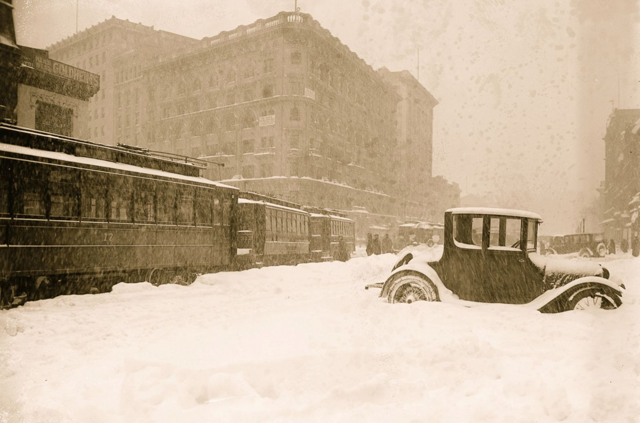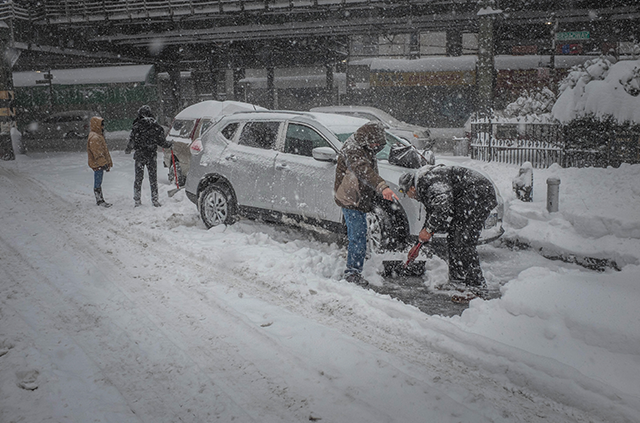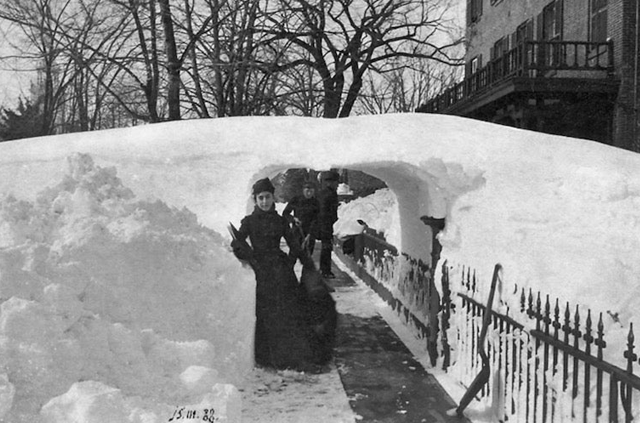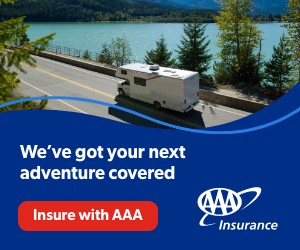If you live in the Northeast, you’ve been through your fair share of snowstorms. You probably even have a memory of your own worst snowstorm – when the snow piled up high against your door, or the power went out, or school was closed for a week. In honor of Mother Nature’s icy and relentless wrath, we present the biggest blizzards and worst snowstorms in United States history.
The Great Blizzard of ’88
In March of 1888, the Northeast was faced with one of the worst blizzards in American history. Also known as the Great White Hurricane, the Great Blizzard of ’88 left as much as 55 inches of snowfall in some areas, and caused disaster wherever it went. The entire area from Washington, D.C., to Maine suffered from brutal winds, massive snowdrifts and catastrophic damage. Over the course of the three-day blizzard, over 400 people were killed. Major cities like New York City and Boston ground to a halt as their railway and telegraph lines were buried or destroyed. The disastrous effects of the Great Blizzard of ’88 actually inspired Boston to create the first underground subway system in the country.

The Knickerbocker Storm – 1922
On Jan. 28, 1922, more than 2 feet of snow fell on Washington, D.C. The weight of the snow collapsed the roof of the Knickerbocker Theatre, killing 98 people. This led to stricter building codes to prevent such a tragedy from ever happening again. To this day, the Knickerbocker Storm holds the record for the most snowfall in D.C., and the Knickerbocker Theater’s collapse remains its deadliest disaster.
The Great Appalachian Storm – 1950
On Thanksgiving weekend of 1950, as much as 62 inches of snow blasted the central Appalachians. As if that wasn’t enough, the area was also beset by frigid cold and intense wind storms. Right after the storm passed, temperatures became unseasonably warm, which led to extensive flooding from the snowmelt. Overall, the Great Appalachian Storm of 1950 caused at least 160 deaths.
The Blizzard of ’78
The Blizzard of 1978 struck on Feb. 5, and didn’t dissipate until two days later. The nor’easter broke snowfall records in Boston (27.1 inches), Providence (27.6 inches) and Atlantic City (20.1 inches). The huge amounts of snow dumped by the storm were matched with hurricane-force winds and coastal flooding. The severity of the blizzard hadn’t been anticipated, and many people were forced to shelter in place for days at a time. Motorists found themselves stranded in their cars in the middle of snowy highways. An estimated 100 people lost their lives.
The Storm of the Century – 1993
In March of 1993, a great cyclonic storm formed in the Gulf of Mexico. As the storm progressed up the East Coast, it began to snow in regions as far south as Alabama and Georgia. The snowstorm stretched from those Southern regions into Maine and even Canada. The affected areas were battered with unseasonably frigid temperatures, powerful wind gusts and up to 60 inches of snow. At one point, every major airport on the East Coast was closed. It was one of the first major storms predicted several days in advance thanks to computer forecast models. While the advanced warnings no doubt saved lives, 318 people still lost their lives. The Storm of the Century is known as one of the deadliest American storms of the 20th century.
The Great Blizzard of 2003
From Valentine’s Day to Feb. 19, the Great Blizzard of 2003 swept across the Mid-Atlantic and the Northeast. Every major city from Washington, D.C., to Boston was covered in an enormous blanket of snow, with many areas getting up to 2 feet. Airports across the Northeast suspended flights and shut down operations completely, while New York City, Boston and Philadelphia transformed into icy ghost towns as residents hunkered down against the bitter cold. The Great Blizzard of 2003 caused 27 deaths and put an entire region of the country on hold.
Snowmageddon – 2010
In February of 2010, two blizzards – one on Feb. 4-7 and one on Feb. 9-11 – hit within just days of each other. Most people agree that “Snowmageddon” refers to the first blizzard, but the second storm is sometimes included in the term. However you define it, it was called “Snowmageddon” for a reason: The storm wreaked havoc across the country, icing over roads in New Mexico and shutting down the federal government in the nation’s capital. The massive storm also led to transportation shutdowns and power outages, and killed 41 people in the U.S. and Mexico.

Snowzilla – 2016
A January 2016 blizzard, hailed as Snowzilla, paralyzed the entire East Coast, leaving hundreds of thousands without power. Snow fell in areas as far south as Georgia, Alabama and even the Florida Panhandle. With intense snowfall, hail, wind gusts and whiteout conditions, it was unsafe to travel even short distances. In all, 55 people lost their lives. The snow reached a maximum height of 42 inches in Glengary, W.V.
December 2022 North American Winter Storm
The most recent storm on the list hit the United States and raged on from Dec. 21 to Dec. 26. The December 2022 North American Winter Storm was a bomb cyclone that buffeted the Midwest and the Great Lakes region with blizzard conditions, even dumping as much as 55 inches of snow in Buffalo, N.Y. A wide swath of the country also experienced extremely cold temperatures, even if they didn’t get hit with any snow. The unprecedented scope of this storm is estimated to have affected 60% of Americans, who received winter weather advisories or warnings, and caused massive disruptions for travelers during the busy Christmas season. As a result of the storm, 91 people across the United States and Canada lost their lives.
What’s the worst snowstorm in United States history that you remember? How did you stay warm? Tell us your story in the comments below.
42 Thoughts on “The Worst Snowstorms in United States History”
Leave A Comment
Comments are subject to moderation and may or may not be published at the editor’s discretion. Only comments that are relevant to the article and add value to the Your AAA community will be considered. Comments may be edited for clarity and length.

















Jan 1985 in San Antonio, Texas saw 13 plus inches of snow in 2 days. The city was paralyzed. We don’t have the snow plows to clear the streets.
No mention of the Blizzard of 1996? I remember coming home not seeing the front of my ranch house because the drifts covered the entire front right up to the top of roof. We got 28″ that storm.
tHE ONLY WEATHERMAN TO ACCURURELY
PREDICTLY THE BLIZZARD OF 1978 WAS
STEWART SUROCCA OF WBZ BOSTON
I had to shelter in place at my friend’s house in Wareham MA during the “100 Hour Storm in 1969.
DISCUSSION: As we step back to February 22-28th, 1969, weather history was most certainly changed forever in a very profound way. This one-week period marked the occurrence of one of the longer snowstorms in recorded history across the New England section of the northeastern United States. The famous “100-Hour Storm” began across the greater Boston, Massachusetts metropolitan area during the earlier parts of this 7-day period. Snow fell much of the time between early on the 25th of February and right through noon on the 28th of February. The 26.3 inches of new snowfall reported at Boston Logan International Airport still remains to be the 2nd largest single snowstorm snowfall total in Boston’s history.
February 1987. not one storm exactly. no school for entire month on cape cod
The blizzard of 1977 was devastating in Buffalo, NY. Several people died in the snow storm. I see the list of blizzards is growing on this site. They are all dangerous, however, the kids love them because the schools are all closed for 3-4 days! Stan K.
The worst snowstorm I remember was in the winter of ’57-’58. Our small town in the western Catskills was closed off from the rest of the world for three days – until larger, stronger snowplows could be brought in from a larger town nearby. Our barn collapsed under the weight of the snow, and farmers had to dump their milk since they couldn’t take it to the creameries. The largest drift (across State Route #10) was measured at 27 feet. My dad took a photo of me standing next to that drift after the snowplows were finally able to get through, and a friend of mine’s father took a photo of him sitting on top of the drift, looking down at the electric power lines.
April 1982, with over a foot of snow.
While maybe not the most snow but it was April. School was shut down for days which as a kid was so fantastic!
April (Fool’s Day) 1997 – Massachusetts got 10-30 inches depending on where you were in the state.
October 2011 – definitely not the snowiest but very destructive. It shut down so many in northeast for 1-2 weeks with loss of power/heat/mobility.
Addie, Yes, the Friday, October 28, 2011 storm was a beaut. I barely made it home from work five miles away, having to change my route multiple times due to impassable roads. The trees snapping all night and through the next morning certainly was one of the craziest situations in which I’ve been.
We finally got the power back on the next Saturday.The Generac sure got a workout during those eight days.
You have left out many snowstorms that happened. !962-63 Northeast had very heavy snow. Interstates closed.
1948-49 northern NJ very heavy snow. I remember bulldozers plowing the roads. 1970’s N.J. had 21 snowstorms.
I remember all of the the blizzards from 1950 to the present.
The Blizzard of ’78 came after several earlier snow storms had dumped many inches of snow in the region. The prior storms had caused school closings and left huge piles of snow. Add in that the storm was only correctly predicted by one weatherman with everyone else dismissing it. Those of us who went to the Beanpot Tournament at the Boston Garden either ended up staying in The Garden or stranded somewhere on our way home. One thing that was great was how everyone helped each other.
Harvey Leonard predicted it.
The only one to nail that forecast was Bruce Schwoegler on WBZ.
The Blizzard of ’66 in upstate NY. The snow was up to our roofline and we were socked in for at least 4 days.
I can’t believe you didn’t include the blizzard of Feb 1966. Roads closed for 3 days in upstate NY.
Back in the 1950’s we had a winter storm that knocked out the electric for days. However, we had a coal hot air furnace and a bottle gas stove. All we needed was candles for light. Back in the good old days in the Berkshires!